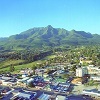GEORGE NEWS - In this article George First Forum queries the wisdom of upholding water restrictions in George under current circumstances.
When engineers design civil engineering services such as roads, storm water, and sewers, these designs are based on the criteria set out in the Guidelines for the Provision of Engineering Services in Residential Townships, called the "Red Book".
Based on the Red Book criteria, the annual average daily water demand of houses (residential Zone I) varies from 500 litres per day up to 3 000 or even 3 400 litres per day. Flats (residential Zones II, III and IV) vary from 450 to 1 000 litres per day. Allowances are also made for offices, shops, schools, hospitals, churches etc. The water consumption for these premises is small in comparison with the consumption of residential units.
Once the total consumption has been determined, the various types of developments are converted to equivalent erven (ee) with one ee = 1 000 litres per day. Based on the ee, the peak factors are then obtained to calculate peak flows, etc.
In George, the average annual daily consumption for houses varies from 750 to 850 litres per day. The reason why it is much lower than the upper limit figures as per the Red Book is because George is situated in an area with high rainfall throughout the year.
Watering of gardens is the main reason for the very high consumption of houses. Due to the high rainfall in George we hardly water gardens, hence the lower consumption of 750 to 850 litres per day.
Rainfall
The average rainfall of George is approximately 660 to 700mm per year. The sources of our municipal water supply are (1) the Garden Route Dam in the Kaaimans River, (2) a weir / pump station in the Malgas River and (3) treated sewer effluent that can be circulated back to the Garden Route Dam. During high rainfall periods as experienced over the last four or five months, nearly all the water needed to cater for the average daily demand is pumped from the Malgas River source to the water treatment works and hardly any water is used from the Garden Route Dam, the main source.
The height that water must be pumped to the water treatment works is approximately 40m from the Malgas river and approximately 60m from the Garden Route Dam. Pumping from the Malgas River is therefore cheaper and the preferred source if sufficient flow of the river is available.
The treated sewer effluent is a standby source and a back-up for extremely dry periods such as we had in 2017. Approximately 10 megalitres of the current 30 megalitres per day consumption is available from the treated sewer effluent if required.
Garden Route Dam
The Garden Route Dam was completed in 1979 and filled for the first time in 1981 after the worst drought recorded at the time. Just for the record, in 1981 the rainfall for George was 1 650mm.
The raising of the dam wall (already planned in 2015) is important and must certainly be done as soon as possible. It is, however, not that critical and it is certainly not necessary that emotions are stirred up, causing panic amongst the residents of George.
Yes, during the period 2009/2010 we had a period of extremely low rainfall where the dam level dropped to ± 16%, but looking at the rainfall records of George, these dry spells occur every 30 to 40 years. The sources of water have been increased since the previous drought to cater for these dry periods.
No base for restrictions
In a recent newsletter, the municipal manager gave eight reasons why water restrictions must be upheld. Based on the aforegoing information, the reasons for upholding water restrictions are unfounded and unacceptable for the following reasons:
- Not all areas in the Western Cape are disaster drought areas.
- The George area is called, for good reason, the Garden Route due to an average annual rainfall of approximately 700mm.
- This rainfall is approximately the same as most cities in Europe. We also have the advantage that our rainfall is year-round.
- Due to our high rainfall as stated above, the average annual consumption of 750 - 850 litres per day of George is already 30 to 40% lower than the consumption of other municipalities. Why then a further 40%?
- Water must be saved, but the alternative way to do it effectively and to bring about a mindset change, is to increase the cost of water.
Make the price of the first 10 to 15 kilolitres per month affordable for residents as per the existing tariffs. Thereafter the price per kilolitre must be increased drastically so that residents can have respect for the cost of water the same as they have for petrol and electricity - certainly these commodities are not more vital than water.
To have emergency rates when the dam level is below a certain percentage or when rainfall is less, is simply ineffective and will not have the required results.
Cape Town's consumption came down to 500-million litres per day only after the price of water was increased drastically. Water usage above a certain amount per month must be so expensive that residents are forced to respect the availability of water.
By increasing the water tariffs for high users, more money will be available for improving the water infrastructure such as raising the dam wall, upgrading and maintenance of the water networks, treatment works, etc.
The municipality has a duty to provide services to its residents. Don't make George residents criminals if they wash their cars or fill their swimming pools occasionally but are prepared to pay a higher price for the extra water used.
Our average daily consumption is already low because of the high rainfall. The amount of water used to wash cars and fill swimming pools is generally very low.
Population growth in George has been a reality for years.
Long-term planning such as the treatment of sewer effluent for re-use, already done by the municipality, is absolutely critical as 60 to 70% of the daily consumption can be circulated back to the dam. Windhoek is a water scarce area and the re-use of treated sewer effluent has been their main source of water for years.
The statement by the George Municipal Manager that George must assist other towns with water supply is simply unfounded and impractical due to the high costs involved. It is the duty of each town to ensure that their long-term planning of resources is in place to cater for the growth of their town.
The aim of this article is not to promote higher consumption or the wasting of water. Let us not base the arguments around water on emotional arguments and assumptions but rather on scientific engineering principles.
By doing this, the public will be well informed of the true facts, which will then automatically create a positive attitude towards saving and, most of all, respecting water as a valuable commodity.
Mr Mayor, Municipal Manager and politicians: You are not engineers. Leave the long-term planning of our water resources and the management thereof in the hands of suitably qualified and experienced engineers.
Article by: Koos Sieberhagen (Pr. Eng) 9 April 2018 - chairman, George First Forum
Read related articles:
'We bring you the latest George, Garden Route news'
















